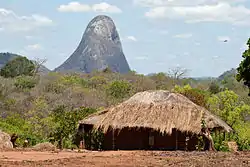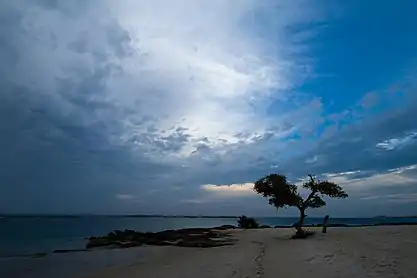Nampula Province
Nampula is a province of northern Mozambique. It has an area of 79,010 km² and a population of 5,758,920, making it the most populous province in Mozambique (2017 census).[2] Nampula is the capital of the province.
Nampula | |
|---|---|
 | |
 Nampula, Province of Mozambique | |
| Country | Mozambique |
| Capital | Nampula |
| Area | |
| • Total | 79,010 km2 (30,510 sq mi) |
| Population (2017 census) | |
| • Total | 5,758,920 |
| • Density | 73/km2 (190/sq mi) |
| Postal code | 31xx |
| Area code(s) | (+258) 26 |
| HDI (2017) | 0.430[1] low · 7th of 11 |
| Website | www |
History
Under Portuguese rule this province was named Moçambique but with independence, the name Mozambique was used for the entire country and the province renamed for its capital. The island, Ilha de Moçambique, was declared a UNESCO World Heritage Site in 1992.[3] Massive refugee movements due to 15 years of civil war have destroyed a unique coexistence of many cultures on this island.
Geography

Nampula Province is located in northeastern Mozambique. It is bordered on the north by Cabo Delgado Province and the Lúrio River, which the Mozambican government has plans to build a 120-megawatt hydroelectric plant on to supply electricity to the province and Cabo Delgado Province.[4] Napula Province borders Niassa Province to the northwest and west, Zambezia Province to the southwest, and the Indian Ocean to the east. The Ligonha River separates it from Zambezia Province; the Makua peoples inhabit the area to the north of the river.[5] From the south, the Malema River flows from the Namuli hills into the Ligonha.[6] The Meluli River flows down through the province in a southeasterly direction, flowing into the Indian Ocean to the south of Angoche Island.[7]
To the west of the city of Nampula, which lies in the heart of the province, are several hilly areas. Mountains in the province include Mount Inago (1804 m), Mount Ribaue, Mount Panda and Mount Nairucu.[8]
Districts

Nampula Province is divided into the 18 districts of:
- Angoche District
- Eráti District
- Lalaua District
- Malema District
- Meconta District
- Mecubúri District
- Memba District
- Mogincual District
- Mogovolas District
- Moma District
- Monapo District
- Mossuril District
- Muecate District
- Murrupula District
- Nacala-a-Velha District
- Nacarôa District
- Nampula District
- Ribáuè District
.jpg.webp)
and the municipalities of:
Economy
The region is a major producer of cotton, and is known as the Cotton Belt of Nampula.[9] Also produced in the province are cashew nuts, tobacco, gems and other minerals. Many of the cotton and tobacco farms in Nampula Province are state-owned.[10]
The Millennium Challenge Corporation (MCC) is involved in a $507 million project with Mozambique to develop the water delivery system in Nampula Province over five years, to benefit an estimated 1.2 million people. The MCC is laying down some 16 kilometers of transmission pipes, constructing or rehabilitating four pumping stations and a new distribution center, and is raising the height of the Nacala Dam from 17 metres (56 ft) to 19 metres (62 ft) and is expanding a treatment plant to enable it to process 1041 cubic meters of water per hour.[11]
Demographics
According to the 1997 census, the province had 2,975,747 inhabitants and an area of 78,197 square kilometres, hence resulting in a population density of 38.05 inhabitants per km². Between 1997 and 2007, the population grew by 25.34%. At the time of the 2007 census, a population of 3,985,613 residents was recorded.[2] With an area 79,010 square kilometres, the population density was about 50.44 people per km².
| Year | Pop. | ±% p.a. |
|---|---|---|
| 1980 | 2,402,700 | — |
| 1997 | 3,063,456 | +1.44% |
| 2007 | 4,084,656 | +2.92% |
| 2017 | 5,758,920 | +3.49% |
| source:[12] | ||

References
- "Sub-national HDI - Area Database - Global Data Lab". hdi.globaldatalab.org. Retrieved 2018-09-13.
- "Mozambique". Geohive. Archived from the original on 24 September 2014. Retrieved 22 September 2014.
- Briggs, Philip (1997). Guide to Mozambique. Bradt Publications. p. 188. ISBN 978-1-898323-45-7.
- "Mozambican government plans to build hydroelectric plant on Lúrio River". Macauhub.com. 1 April 2014. Retrieved 22 September 2014.
- Encyclopedia of African Peoples. Routledge. 26 November 2013. p. 62. ISBN 978-1-135-96334-7.
- White, Landeg (14 September 1989). Magomero: Portrait of an African Village. Cambridge University Press. p. 97. ISBN 978-0-521-38909-9.
- Spalding, Mark (23 September 2010). World Atlas of Mangroves. Routledge. p. 62. ISBN 978-1-136-53096-8.
- Africa Annual. Foreign Correspondents, Limited. 1958. p. 66.
- Moseley, William G.; Gray, Leslie C. (1 April 2008). Hanging by a Thread: Cotton, Globalization, and Poverty in Africa. Ohio University Press. p. 82. ISBN 978-0-89680-461-6.
- Pitcher, M. Anne (14 November 2002). Transforming Mozambique: The Politics of Privatization, 1975–2000. Cambridge University Press. p. 93. ISBN 978-1-139-43494-2.
- "Water, drainage investments support urban boom in northern Mozambique". Millennium Challenge Corporation. Retrieved 22 September 2014.
- Cameroon: Administrative Division population statistics
External links
| Wikimedia Commons has media related to Nampula Province. |
- (in Portuguese) Nampula Province official site